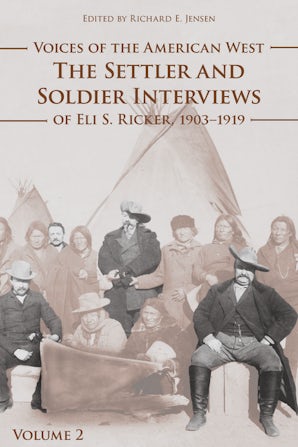List of Illustrations
Introduction
Map: The West of Eli S. Ricker
Chapter One: Wounded Knee
1. Peter McFarland. Wounded Knee
2. Charles W. Allen. Wounded Knee
3. Meded Swigert. Wounded Knee
4. Guy Vaughn. Wounded Knee
5. Francis M. J. Craft. Wounded Knee
6. John W. Butler. Wounded Knee
7. James R. Walker. Wounded Knee
8. George E. Bartlett. Biography, Wounded Knee
9. George A. Stannard. Wounded Knee
10. Joseph Kocer. Wounded Knee
11. W. F. Clark. Wounded Knee
12. E. C. Swigert. Wounded Knee
13. W. A. Birdsall. Wounded Knee
14. Cornelius A. Craven. Wounded Knee
15. James White. Wounded Knee
16. John H. Dixon. Wounded Knee
17. T. L. Williams. Wounded Knee
18. W. A. Ballou. Wounded Knee
19. Elbert Mead. Wounded Knee
20. Eli S. Ricker. Wounded Knee
Chapter Two: Agents and Agencies
1. Mr. and Mrs. E. M. Keith. Wounded Knee, Pine Ridge agents
2. Robert O. Pugh. Pine Ridge agents, Ghost Dance, Sioux Customs
3. H. A. Mossman. Pine Ridge agents
4. A. F. Johnson. Pine Ridge missions
5. William J. Cleveland. Sioux missions
6. Edmund Thickstun. Sioux customs, Indian-white relations
7. John R. Brennan. Pine Ridge reservation
8. George Stover. Biography, Franck Grouard, Pine Ridge Reservation, Pine Ridge agents
9. John B. Sanborn. Sioux reservation boundaries
10. Ollufine Nelson. Yellow Medicine Agency
11. Peter B. Nelson. American Horse, Yellow Medicine Agency
12. Mabel M. Dawson. Fort Sill Indian School, Geronimo
Chapter Three: Little Bighorn
1. A. F. Ward. Little Bighorn
2. Charles Clifford. Little Bighorn, Yellow Horse's account
3. Edward H. Allison. Little Bighorn, Lieutenant Harrington's death, Gall
4. Edward S. Godfrey. Little Bighorn
5. F. E. Server. Little Bighorn, Frank Grouard, Lame Deer fight, Crow agencies, Jim Bridger
6. Walter Q. Tucker. Little Bighorn
7. Archie Smith. Little Bighorn
Chapter Four: Beecher Island
1. Allison J. Pliley. Beecher Island fight
2. John J. Donovan. Beecher Island fight
3. Beecher Island Veterans. Beecher Island fight
Chapter Five: Lightning Creek Incident
1. Eli S. Ricker. Lightning Creek incident
2. Hugh Houghton. Lightning Creek incident
3. Roy Lemons. Lightning Creek incident
4. Isaac Robbins. Lightning Creek incident
Chapter Six: Biographical Sketches
1. W. R. Jones. Connor, Bissonette, Little Big Man, Crook, Sechler, Salaway, Little Bat, Pine Ridge Agency, Fort Mitchell, Red Cloud
2. L. B. Lessert. Fort Casper, the Bakers, Bridger, Yellow Medicine Agency, Pine Ridge agents, Beckwourth
3. Alexander Baxter. Scouts and interpreters, agents, Indian leaders, 1868 Fort Laramie treaty
4. Harry Dean. Wild Bill Hickok
5. John W. Brafford William F. Drannan
6. Marion Spencer. Bridger and Vasquez
Chapter Seven: The Old West
1. Magloire Mousseau. American Fur Company, Ash Hollow fight, Fort Casper, Fort Laramie, Kelly, Larimer, and Wakefield, scouts, traders, officers, and agents
2. George W. Colhoff. Galvanized Yankees, treaties and reservations, the Richards, Frank Grouard, Bridger, Little Bat, Pine Ridge agents, Red Cloud
3. Carter P. Johnson. Cheyenne outbreak, Sidney-Deadwood stagecoach robberies, Apache Kid
4. Baptiste Pourier. Biography, the Richards, Bozeman Trail forts, Rosebud fight, Slim Buttes fight, Crazy Horse, Sibley Scout
5. Richard C. Stirk. Flagpole at Red Cloud Agency, Slim Buttes fight, Wounded Knee
6. Ben Tibbitts. Washita fight, Flagpole at Red Cloud Agency, Wounded Knee
7. Heber M. Creel. Cheyenne outbreak
8. William L. Judkins. Mackenzie-Dull Knife fight
9. David Y. Mears. Sibley Scout, Cheyenne outbreak
10. Jacob A. Augur. Cheyenne outbreak
11. A. G. Shaw. Eleventh Ohio Cavalry, Platte Bridge fight, Rush Creek fight, Horse Creek fight, Custer's dead, Spotted Tail, Crazy Horse
12. Peter Abraham Deon. American Fur Company, Father DeSmet, Horse Creek treaty, Red Cloud
13. John Russell. The Richards, Kelly, Larimer, and Wakefield, scouts, traders and officers, Wounded Knee
14. Augustus W. Corliss. Biography, Wounded Knee, officers and Indians
15. John C. Whalen. Powder River campaign, Platte Bridge fight, Wounded Knee
16. John W. Irion. Rawhide Creek legend, Masonry and Indians, Sand Creek
17. A. W. Means. Sand Creek
18. John M. Comegys. Scouts and officers
19. William H. Taylor. Crook's 1876 campaign
20. Mr. and Mrs. William H. Robertson. Grattan fight
21. Allison J. Pliley. Prairie Dog Creek fight
22. William Holdaway. U.P. Railroad construction
23. John Burdick. Custer
24. William A. Coffield. Telegraph at Fort Robinson
25. James H. Cook. William F. Cody, The Texas Trail
26. Donald Brown. Warbonnet fight, Slim Buttes fight
27. Winfield S. Ake. Camp Lyon, Paiutes
28. Joseph Bingaman. Washita fight
29. George A. Leclere. Whitestone Hill fight, Badlands campaign
30. Mr. and Mrs. John Farnham. Red Cloud
31. Charles J. Brown. Treaties with the Sissetons, Wahpetons, Medewakantons, and Wapecootahs
Appendix A: Forts
Notes
Bibliography
Index
